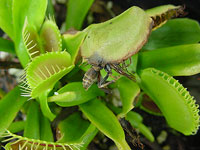The Design in Nature
The fact that living things have perfectly designed forms proves that they could never have originated by chance. The design in nature is a clear sign of creation.
 |
This is not the head of a snake but the tail of a caterpillar! In a moment of danger, the caterpillar puffs up its tail which is designed to look exactly like a snake's head and intimidates its enemies. |
 |
A PERFECT HUNTER: THE VENUS' FLYTRAP A carnivorous plant, the Venus' Flytrap, is a perfect hunter that swiftly catches the flies landing on it. It is impossible for this trap system working with electric signals to be the work of coincidence or a gradual developmental process. The perfect design of the Venus' flytrap is one of the numerous signs of creation. |
What would you think if you went out trekking in the depths of a thick forest and ran across a latest-model car among the trees? Would you think that various elements in the forest had come together by chance over millions of years and produced such a vehicle? All the raw materials making up the car are obtained from iron, plastic, rubber, earth or its by-products, but would this fact lead you to think that these materials had come together "by chance" and had, by themselves, manufactured such a car?
Without doubt, anyone with a sound mind would know that the car was the product of an intelligent design, that is, it was factory-made, and would wonder what it was doing there in the middle of a jungle. The sudden origination of a complex structure in a complete form out of the blue shows that it is made by an intelligent agent.
The example of the car also holds true for living things. In fact, the design in life is too striking to be compared to that in a car. The cell, the basic unit of life, is far more complex than any man-made technological product. Moreover, this irreducibly complex organism must have emerged suddenly and fully formed.
Therefore, it is crystal clear that all living things are the work of a superior "design". To put it more clearly, there is no doubt that all creatures are created by God.
 | ||
This is not the head of a snake but the tail of a caterpillar! In a moment of danger, the caterpillar puffs up its tail which is designed to look exactly like a snake's head and intimidates its enemies. | This fish is created with a very interesting hunting system. It keeps this system undisclosed under normal conditions. | The prey, lured by the fake fish, draws near and suddenly falls a victim to it. |
In the face of this explicit truth, evolutionists resort to a single concept: "chance". By believing that pure chance can produce perfect designs, evolutionists cross the bounds of reason and science. The famous zoologist Pierre Grassé, the former president of the French Academy of Sciences, makes his point about the logic of "chance", which is the backbone of Darwinism:
 |
THE DESIGN IN OUR HANDS The human hand has a perfect design that gives us ideal movement ability. Each one of the 27 small bones making up the hand is positioned properly with a certain engineering calculation. The muscles that help us to move our fingers are located in our lower arms so as not to make our hands clumsy. These muscles are connected by strong tendons to three small bones in our fingers. Moreover, there is a special bracelet-like tissue in our wrists that fastens all these tendons. The hand has such a perfect design that no "robot hand" produced by modern technology has been able to imitate the abilities of the hand. |
The opportune appearance of mutations permitting animals and plants to meet their needs seems hard to believe. Yet the Darwinian theory is even more demanding: A single plant, a single animal would require thousands and thousands of lucky, appropriate events. Thus, miracles would become the rule: events with an infinitesimal probability could not fail to occur… There is no law against daydreaming, but science must not indulge in it.12
Grassé summarises what the concept of "coincidence" means for evolutionists: "...Chance becomes a sort of providence, which, under the cover of atheism, is not named but which is secretly worshipped."13
This is the type of superstition that underlies Darwinism.
 | BONE AND THE EIFFEL TOWER
Examples of design in nature often become a source of inspiration for technological designs. An example is the spongy structure of the human bone furnished with small tendons, which inspired the famous Eiffel Tower in Paris. This structure is responsible for the strength, elasticity, and lightness of bones. The same properties also exist in the Eiffel Tower, though not as effectively as in bones. | |
Footnotes
12) Pierre-P Grassé, Evolution of Living Organisms, New York: Academic Press, 1977, S. 103
13) Pierre-P Grassé, Evolution of Living Organisms, S. 107
- An Outdated View: The Theory of Evolution
- The Origin of Life
- The Design in the Protein
- The Design in the Cell
- Genetic Information
- The Design in Nature
- Miller's Experiment
- The Natural Selection Misconception
- Mutations
- Irreducible Complexity
- Impasse of Intermediate Forms
- The Cambrian Period
- Fish and Amphibians
- Coelacanth Misconception
- Reptiles
- Birds and Reptiles
- Archaeopteryx Misconception
- Bird Feathers
- The Origin of Mammals
- Living Fossils
- The Tale of Man's Evolution
- Australopithecus
- Homo Erectus
- A Lost Human Race: Neanderthals
- The Collapse of the Family Tree
- The Bipedalism Impasse
- False Faces
- Piltdown Scandal
- Why is Evolution Defended?
- The Obvious Truth: Creation
